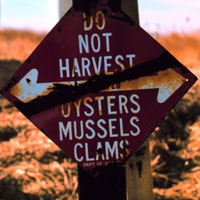

Karenia brevis, often called the “Florida Red Tide,” is a highly toxic alga that causes human respiratory distress, shellfish toxicity, animal mortalities, and water discoloration. K. brevis blooms throughout the Gulf of Mexico, and is occasionally transported to the Southeast U.S. coast. In U.S. waters, the blooms occur almost annually in the fall along the West Florida Shelf, and less frequently in other coastal areas, resulting in major impacts on human health, tourism, shellfish industries, and ecosystems, capturing the attention of the public and media.
In January, 2005, an unusually early and large bloom of K. brevis developed
on the West Florida
Shelf, leading to mass fish kills and reports of human respiratory
irritation. In the early summer, the bloom receded to an area in southern
Tampa Bay, but then a unique set of oceanographic conditions caused
the bloom to expand offshore and become trapped near the bottom where
mortalities of some fish and bottom-dwelling organisms resulted from
contact with K. brevis toxins. The decaying animals and K.
brevis cells caused depletion of bottom water oxygen, which led
to mass mortalities of diverse organisms across stretches of sea-bottom
including coral reef environments.Data collected by Center for Sponsored Coastal Ocean Research (CSCOR)-funded researchers and the State of Florida, with assistance from local
divers, indicated that the impacts were widespread, affecting an area
of over 2,162 miles 2 west of central Florida.  The last time wide spread
bottom water anoxia occurred in the same area was 1972, according to
Florida's Fish and Wildlife Research Institute. Unusually high numbers
of manatee, dolphin, and turtle deaths during the 2005 bloom have prompted
the first ever declaration of a multiple species Unusual Mortality
Event, triggering an intensive investigation under the Marine Mammal
Protection Act.
The last time wide spread
bottom water anoxia occurred in the same area was 1972, according to
Florida's Fish and Wildlife Research Institute. Unusually high numbers
of manatee, dolphin, and turtle deaths during the 2005 bloom have prompted
the first ever declaration of a multiple species Unusual Mortality
Event, triggering an intensive investigation under the Marine Mammal
Protection Act.
For more information on CSCOR's HAB programs, please
visit
www.cop.noaa.gov/stressors/extremeevents/hab/
CSCOR has invested more than $12 million since 1997 to help Gulf of Mexico coastal managers reduce public health risks and economic impacts of K. brevis through its support of the Ecology and Oceanography of Harmful Algal Blooms (ECOHAB) and Monitoring and Event Response for Harmful Algal Blooms (MERHAB) programs. One investment example is the NOAA- and EPA-funded “ECOHAB: Florida” project, which involved Florida state managers, academic institutions, local governments, and business organizations. “ECOHAB: Florida” researchers studied K. brevis bloom dynamics for five years, compiled one of the longest-running datasets (48 years) for HAB research and coastal ecosystems in general, and developed a complex model to tease out important environmental factors controlling blooms. A MERHAB-funded monitoring network now employs this biophysical model for tracking and predicting Karenia blooms. CSCOR's HAB programs continue to strive to advance scientific understanding and our ability to detect, predict, control, and mitigate HAB events.